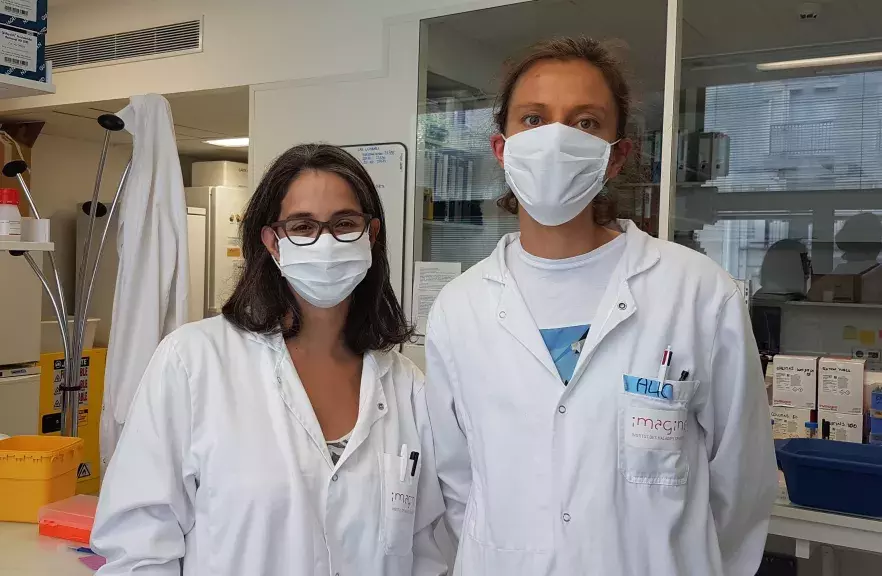Published on 01.03.2022
Since its discovery in 2015, only 60 people have been diagnosed with COPA syndrome. Patients with this a priori very rare condition have a variety of symptoms that affect the lungs, kidneys and joints in particular. It can even be asymptomatic. Exploration of this genetic disease has recently revealed an increased level of type 1 interferon (IFN-1). These proteins begin to be produced within minutes of being infected by a virus in our cells and carry the message of the attack throughout the body. This rapid and immediate immune response occurs regardless of the virus.
The risk of too much interferon
However, although essential, interferons produced in too large quantities become toxic. In immunity, it is all a question of balance: an exacerbated response is not without risk: "Overactivation of IFN-1 causes type 1 interferonopathies, rare genetic diseases that probably affect less than a thousand people worldwide. These diseases are generally very severe and can affect various organs simultaneously, in particular the brain, the lungs and the skin," explains Marie-Louise Frémond, a future pediatrician at the Necker-Enfants malades hospital (AP-HP) and a post-doctoral fellow in the neurogenetics and neuroinflammation laboratory directed by Yanick Crow at the Imagine Institute.
COPA syndrome and SAVI: many similarities
Among the type 1 interferonopathies, the symptoms observed in one of them, STING-associated vasculopathy with onset in infancy (SAVI), were reminiscent of COPA syndrome. SAVI is a genetic autoinflammatory disease caused by constitutive activation of the STING (for Stimulator of Interferon Genes) protein. Patients suffer from systemic inflammation and vasculopathy affecting small vessels, resulting in severe skin, lung and joint damage.
The STING protein is involved in the DNA recognition mechanism in the cytosol, the liquid phase in which cell organelles are immersed and in which no DNA should supposedly be present," describes Alice Lepelley, a post-doctoral fellow in the same team. The presence of this DNA fragment then acts as a signal of the presence of a viral infection, because the virus after infecting a cell releases DNA fragments into the cytosol. When they are found, the STING protein is activated and then goes to a compartment of the cell, the Golgi apparatus, to induce the production of IFN-1.
So the researchers wanted to know if the COPA protein - which gave its name to COPA syndrome because of its alteration - was involved in this process. So they looked at what happens in cells and other models when COPA and STING are turned on or off together, or separately...
"When COPA is mutated, there is an accumulation of STING in the Golgi apparatus, which led us to hypothesize that COPA has a role in trafficking STING to and from the Golgi," explains Marie-Louise Frémond. In SAVI patients, due to a mutation in STING, the protein spontaneously accumulates in the Golgi in the absence of any infection and induces a continuous production of IFN-1. In COPA syndrome, it is the COPA mutation that would prevent the removal of STING once it is present in the Golgi.
Without COPA, STING's activity is not regulated
"We knew that COPA was part of a complex forming vesicles that transport proteins between the endoplasmic reticulum, where the proteins are produced, and the Golgi apparatus, where they finish being 'prepared' for their future function," recalls Alice Lepelley. Our work suggests that mutations in COPA interfere with the proper transport of STING, but there is no direct link between these two proteins. There are certainly intermediaries that we need to discover.
In parallel, two other studies confirm that the induction of IFN-1 by the mutated COPA protein is dependent on STING and identify a possible partner between STING and COPA. "In our opinion, it is not the only one," adds Marie-Louise Frémond. Further research is needed to better understand this mechanism, which is already a potential therapeutic target for reducing the harmful excess of IFN-1.
The young pediatrician is therefore continuing to recruit patients with COPA syndrome to increase the cohort she is currently studying, which is composed of 11 patients, which, given the rarity of the disease, is not easy and requires mobilizing a network of pediatric pulmonologists in particular. "It is very likely that some patients followed in these services and in others, including in adult medicine, have not been identified to date as carriers of a COPA mutation. This is one of the great difficulties associated with the study of rare diseases.


